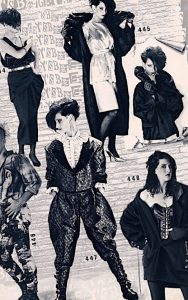Black Fashionguide of the 80s - Between Bogey's catalog and reality
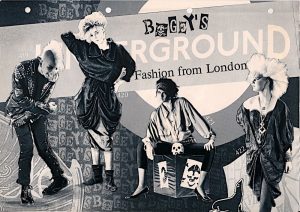 Who entered the scene of the Gothics and Waver in the 80s needed appropriate clothes. As an external recognition feature of the scene affiliation it had failed, extravagant and of course black. Those who were not able to become creative themselves had to provide themselves with scene clothing in the European main cities or to resort to one of the mailorder senders. An 18-page catalog of "Bogey's Underground Fashion from London", which reached me through a friendly reader by e-mail, inspired me to contribute to the black fashion of the 80s.
Who entered the scene of the Gothics and Waver in the 80s needed appropriate clothes. As an external recognition feature of the scene affiliation it had failed, extravagant and of course black. Those who were not able to become creative themselves had to provide themselves with scene clothing in the European main cities or to resort to one of the mailorder senders. An 18-page catalog of "Bogey's Underground Fashion from London", which reached me through a friendly reader by e-mail, inspired me to contribute to the black fashion of the 80s.
Did everything in the catalog really have to do with the scene? Is not something already mixed up in his roots, which will never belong together?
I can anticipate that not all images match the content, but this is simply not possible due to the really "colorful" mixture of the catalog of clothing from the most diverse scenes and marginal areas of many subcultures. So it is about fashion, not necessarily about background and content.
The origin of everything
Punk
 The black style was born in the UK. In the mid-1970s, the punk movement turned out to be the motor of difference. The "garbage look" was an expression of her vitality: "It has no purpose anyway" (No Future). With their clothes, they symbolized their attitude to supremacy and shocked the public. The punks made the ugly a clothing strategy of attention excitement.
The black style was born in the UK. In the mid-1970s, the punk movement turned out to be the motor of difference. The "garbage look" was an expression of her vitality: "It has no purpose anyway" (No Future). With their clothes, they symbolized their attitude to supremacy and shocked the public. The punks made the ugly a clothing strategy of attention excitement.
 The black style was born in the UK. In the mid-1970s, the punk movement turned out to be the motor of difference. The "garbage look" was an expression of her vitality: "It has no purpose anyway" (No Future). With their clothes, they symbolized their attitude to supremacy and shocked the public. The punks made the ugly a clothing strategy of attention excitement.
The black style was born in the UK. In the mid-1970s, the punk movement turned out to be the motor of difference. The "garbage look" was an expression of her vitality: "It has no purpose anyway" (No Future). With their clothes, they symbolized their attitude to supremacy and shocked the public. The punks made the ugly a clothing strategy of attention excitement. The central element of their clothing was the black leather jacket, which already had to show use traces with its first wear. Letterings, patches and a whole armada of rivets in all forms and finishes were a must. (419)
The central element of their clothing was the black leather jacket, which already had to show use traces with its first wear. Letterings, patches and a whole armada of rivets in all forms and finishes were a must. (419)
The youngsters began to focus the shock effect by placing safety pins in their ears, mouths, or cheeks, and connecting them with chains. Symbols put the crown on the whole. Idols like Johnny Rotten and Siouxsie Sioux made an excitement and fashion accessory from the Hakenkreuz at the same time, laying the foundation for this kind of symbolic provocation. By deliberately destroying the connection between the symbol and the symbolized, the punks performed a kind of aesthetic pioneering work for many subsequent scenes, which the Gothics in particular took up again.
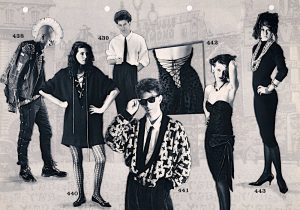 With the punks the hair gained a very special importance. Red, green, yellow, or blackish-colored, hairstyles made with sugar-water, which were shaved off at the sides or neck, became a characteristic feature of this youth culture. (427 & 428) The predecessors of modern Gothics adopted this style and continued it.
With the punks the hair gained a very special importance. Red, green, yellow, or blackish-colored, hairstyles made with sugar-water, which were shaved off at the sides or neck, became a characteristic feature of this youth culture. (427 & 428) The predecessors of modern Gothics adopted this style and continued it.
At the end of the 1970s this species emerged mainly in the European capitals. They wore suits of the 1950s, which were unmistakable with wide shoulders and narrow lapel. (441) They wore wide trousers that narrowed to the ankles and found their perfection in the pointed shoes, the so-called Pikes or Winklepickern.
As an accessory, one liked to use glasses, while in the make-up style hard contours and lines prevailed. With the ironic imitation of the "normal", with the meticulous adherence to the bourgeois clothes of the fifties, the New Waver held a critical mirror in front of society, and on the other, they were confused by this accomplished imitation. (451/454)
Feminine New Waver captured by figurative cuts (443) and interrupted stylistic accuracy through high-haired and shaved hairstyles. Large-area jewelery emphasized the decollete and wide belt helped to a narrow waist. Optionally to the tight skirt were also worn over the top (433) or high-cut blouses with wide, puffy sleeves (453).
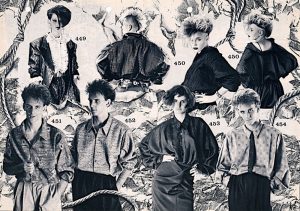 The New Waver is a rendezvous on the way to modern Gothic and developed also in other Lebensbereichen in a completely different direction. The catalog of Bogey's unfortunately shows this style on the same level as other youth cultures of this time, without taking into consideration the actual development of the Gothics. The mixing of youth cultures into a large black mass probably begins with the commercialization of clothing.
The New Waver is a rendezvous on the way to modern Gothic and developed also in other Lebensbereichen in a completely different direction. The catalog of Bogey's unfortunately shows this style on the same level as other youth cultures of this time, without taking into consideration the actual development of the Gothics. The mixing of youth cultures into a large black mass probably begins with the commercialization of clothing.
Many were the punks ugly and the New Waver too dreary, they developed in a completely different direction. The New Romantics were inspired by the style of clothing of long-standing epochs. Frilly shirts, wide flowing trousers and skirts, made of fabrics with imaginative ornamentation, captured in their style (447). They wore ample jewelery and made themselves strongly with striking, bright colors.
The New Romantics enchanted living images of the switch, they witnessed elegance and splendor. They gave themselves to the glamorous and developed to "Edel-Punks", their hairstyles resemble those of the punks, their pointed shoes the New Wavern. By putting the elegant in the place of the sloppy and the noble in the place of the vulgar, and putting it in the place of the defeat, they became anti-punks.
After punk was also successfully marketed by Vivienne Westwood and Malcom McLaren , other fashion designers also took up the style and made influences from the scene fashion for the masses. On the stage Adam & The Ants, Steve Strange, Boy George, and many others were at the disposal of the young people as a fashionable model, which they could also play with due to the start of the production of live music. Bogey's profit from the empty German market in the middle of the 80s and reached a high level of awareness through clever advertising in youth magazines.
Gothic - The birth of a fashion
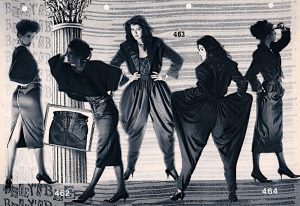 At the beginning of the 80s the Gothics rose from their trenches. No one knew how to sort the pale-painted figures dressed in black, so they were placed in the musical environment to which they seemed to belong. The leading scene club was the Batcavein the British capital of London, which alone had already made possible the conclusion of its ambience by the logo of its membership card (the contour of a bat). The decor was predominantly in the colors black, blood red and purple, while the decoration dominated velvet, sequins, spiderwebs and metallic elements. An ideal setting for every Horrorfilm. Just as the interior furnishings appeared, the visitors, who were waiting for weddings in meters of snakes in front of the club. The faces pale and eyes black painted, while their bodies were hung with black drapery.
At the beginning of the 80s the Gothics rose from their trenches. No one knew how to sort the pale-painted figures dressed in black, so they were placed in the musical environment to which they seemed to belong. The leading scene club was the Batcavein the British capital of London, which alone had already made possible the conclusion of its ambience by the logo of its membership card (the contour of a bat). The decor was predominantly in the colors black, blood red and purple, while the decoration dominated velvet, sequins, spiderwebs and metallic elements. An ideal setting for every Horrorfilm. Just as the interior furnishings appeared, the visitors, who were waiting for weddings in meters of snakes in front of the club. The faces pale and eyes black painted, while their bodies were hung with black drapery.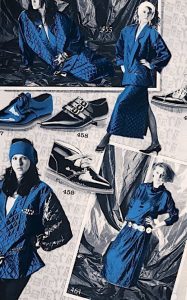 They differed from all the scenes preceding them by important external features. The punks appeared as an aestheticization of the ugly, the New Waver ironized the normal and the New Romantics appeared as a revival culture of the glamorous past times. The Gothics were different, they staged the horror. " Black clothing (with a hint of purple), often with fetishistic, historical, religious or occult reflections, deathly pale complexions, black and red cosmetics, heavy silver jewellery and black, spiky hait characterise this style. " 1 In their clothing style, the Gothics built on the origins of black fashion and adopted important elements in order to differentiate themselves in the course of individualization.
They differed from all the scenes preceding them by important external features. The punks appeared as an aestheticization of the ugly, the New Waver ironized the normal and the New Romantics appeared as a revival culture of the glamorous past times. The Gothics were different, they staged the horror. " Black clothing (with a hint of purple), often with fetishistic, historical, religious or occult reflections, deathly pale complexions, black and red cosmetics, heavy silver jewellery and black, spiky hait characterise this style. " 1 In their clothing style, the Gothics built on the origins of black fashion and adopted important elements in order to differentiate themselves in the course of individualization.
The "Gothic-Gothic"
 The Gothic-Gothic is the classical Gothic, which was then as rare as today. It was not until the mid-80s that the term "Gothic" extended a fashionable umbrella over all other clothing styles of the subculture. Wide, flowing, body-covering clothing was stylistic for the classical Gothic. They wore cloaks, gowns, cloaks, and wide coats with wide sleeves. It was assumed that the wearer goes to a distanced attitude toward his own body 2 and, by the way, he also emphasizes the social characteristics of the sexual identity.
The Gothic-Gothic is the classical Gothic, which was then as rare as today. It was not until the mid-80s that the term "Gothic" extended a fashionable umbrella over all other clothing styles of the subculture. Wide, flowing, body-covering clothing was stylistic for the classical Gothic. They wore cloaks, gowns, cloaks, and wide coats with wide sleeves. It was assumed that the wearer goes to a distanced attitude toward his own body 2 and, by the way, he also emphasizes the social characteristics of the sexual identity.
The gown is a long-sleeved and knochellanges amtskleid, which was already known by lawyers, academics and clergymen. The cloaks (capes) are coat-like garments without sleeves, which were originally worn with hood. The Spaniards of the 16th century used this as a typical piece of clothing for the gentlemen. The monks were shamelessly stealing their cloaks, a mostly straight-cut or tunic-like shirt gown. The typical long leather coat with wide sleeves often also referred to as a cowl.
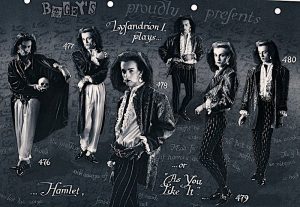 Capes can still be found today in relevant catalogs of the scene, even though they have clearly gained in quality in their present-day designs and are often made of high-quality velvet lined with red inner lining. On the other hand, the gowns, priests, and monk's robes have almost disappeared, since their simplicity in the course of individualization was no longer sufficient.
Capes can still be found today in relevant catalogs of the scene, even though they have clearly gained in quality in their present-day designs and are often made of high-quality velvet lined with red inner lining. On the other hand, the gowns, priests, and monk's robes have almost disappeared, since their simplicity in the course of individualization was no longer sufficient.
The Waver
The stereotype, which was widespread in the scene, carried very wide trousers, bodices with bat sleeves, wide coats and jackets. The Pumphosen was a central feature of the Wavers (463), which found its worthy conclusion in the shape of the pointed shoes of the New Waver (458).
 She is a long, wide, sack-shaped trousers without pockets, tightens at the ankles. It can be traced back to the army which was worn in Spain in the sixteenth century and was often filled with rosshaar on the hip, in order to exacerbate the desired form. At the end of the 19th century, women's rights activist Amelia Bloomer developed a similar trousers called "Turkish Trousers" or "Bloomers". The pikes finished the slimmer ends of the pants with their often impressive tops.
She is a long, wide, sack-shaped trousers without pockets, tightens at the ankles. It can be traced back to the army which was worn in Spain in the sixteenth century and was often filled with rosshaar on the hip, in order to exacerbate the desired form. At the end of the 19th century, women's rights activist Amelia Bloomer developed a similar trousers called "Turkish Trousers" or "Bloomers". The pikes finished the slimmer ends of the pants with their often impressive tops.
The billiards, which were brought to Europe by cruisers from the Orient 3 , are a recurring element of the 80s. At the time of rococo and baroque, the buckles and ornaments for shoes 4 , which are found at the pikes, are reincarnated. The waders, however, took over the shoes from the early subcultures of the 60s and 70s, where the mods provided for a revival of pointed shoes, later re-fashioned by the New Waver.
The romantics
 They turned the New Romantics into the black fashion world of Gothics. The romantics showed themselves masterfully in dealing with historical elements of the clothing and sampled through all the centuries around them to a new style. Feminine romantics were characterized by wide skirt and dress forms, which were additionally adorned with cloaks and head-dresses. Even narrow and deeply cut tops and bodices were already found in the 80s. They play with elements of the Burgundian fashion of the 15th century and above all with the baroque and rococo elements of the 17th and 18th century without taking into consideration historical connections.
They turned the New Romantics into the black fashion world of Gothics. The romantics showed themselves masterfully in dealing with historical elements of the clothing and sampled through all the centuries around them to a new style. Feminine romantics were characterized by wide skirt and dress forms, which were additionally adorned with cloaks and head-dresses. Even narrow and deeply cut tops and bodices were already found in the 80s. They play with elements of the Burgundian fashion of the 15th century and above all with the baroque and rococo elements of the 17th and 18th century without taking into consideration historical connections.
Male romantics preferred wide shirt shapes and tight, body-reinforced pants. The romantically playful ruffle shirt (479), on sleeves and the chest area with numerous frills, is in all variations is central element of the male style.
 Frequently used fabrics are velvet, lace and ruffles, which stand for luxury and elegance and a romantic past to remember. Ruffles have their roots in Rococo, lace is one of the achievements of the Italian High Renaissance. Velvet has its origins in the Middle Ages, in which it was even more precious and coveted than silk.
Frequently used fabrics are velvet, lace and ruffles, which stand for luxury and elegance and a romantic past to remember. Ruffles have their roots in Rococo, lace is one of the achievements of the Italian High Renaissance. Velvet has its origins in the Middle Ages, in which it was even more precious and coveted than silk.
Latex, lacquer and leather
In the late '80s, the corset and bodice appeared in the garbo's outerwear (490). Clothing pieces made of lacquer and leather are first adopted in elements, later completely in fashion. Initially taken from stylistic features of the romantics, one discovers the bodice with overlaps from the SM scene as an erotic stylistic device. Apparently, a tied and constrainedly narrowed waistline observer and wearer alike. Lacquered lacquer finishes match the feminine style of New Waver. (494 & 497)
The return to body-stressed features of the body is a phenomenon of the late 80s. While at the beginning of fashion they tried to conceal their own bodies and make them unrecognizable in gender and expression, one went back to the end of the decade in a clearly gender-oriented way of the clothing style. Pikes and pointed pumps with small heels were pushed out by ever higher plateau shoes and chunky boots, floor-length robes waving fishnet stockings and mini-skirts.
 While latex, varnish and leather in the SM scene function as material fetish, most gothics are more concerned with the external appeal and with the play with the forbidden and spoofing. Only a few are actually attracted to a Sado-Masochistic sexuality.
While latex, varnish and leather in the SM scene function as material fetish, most gothics are more concerned with the external appeal and with the play with the forbidden and spoofing. Only a few are actually attracted to a Sado-Masochistic sexuality.
everyday
" Black, black, black are all my clothes; Black, black, black is all I have. That's why I love everything that is so black ... "
Despite the outward rebellion, against the colorful and neongrellen 80er many Gothics in the life of the society. Even if one remains faithful to the color, one tried to reduce the optical rebellion to a socially acceptable level. Dresses in the normal range marked many scene-goers in everyday life. They used comfortable jeans and leather pants, t-shirts and sweatshirts, which are decorated only by rivet belts or band logo.
Today's everyday clothing of the Gothics has become more extreme. Only with increasing social acceptance in the course of the decades is more and more borne of the style of the scene in everyday life. As a result, the outfits reserved for "scene evenings" are becoming increasingly extreme in order to be able to exclude themselves from everyday life within the scene. I claim fetish clothing, cyber-fashion, and increasingly extreme body wear are the consequences of wider acceptance. In the early '80s black hair, which had been shaved off at the sides, was a clear signal of the exclusion, nowadays high heels, lacquer & leather, gas masks, dog leashes and a lot of skin are needed to give a similar signal.
"The hair is the most important!"
hairstyles
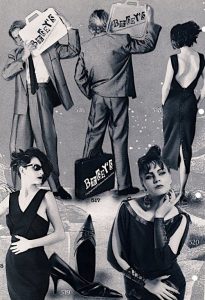 Why do I talk about hair when it comes to clothing? Well, an investigation among teenagers showed that 68% 5 of all respondents felt that the hair style was the most important on the overall outfit. Under Gothics these values should have been much higher in the 1980s.
Why do I talk about hair when it comes to clothing? Well, an investigation among teenagers showed that 68% 5 of all respondents felt that the hair style was the most important on the overall outfit. Under Gothics these values should have been much higher in the 1980s.
The hair was similar to the punks high-heeled and partly elaborately staged. In hours of sitting in front of the mirror under the use of plentiful hairspray, the most elaborate creations were created. To put the cover hair on a tower, while the sides and neck were shaved off, is one of the most original scene dresses. In the plate (also called Tellermine or Tellerschädel), the covering hairs are placed into a flat, plate-shaped structure which widens outwards from the nape and the sides.
 While these hairstyles were rather worn by men, the women followed other styles. The "haired hair" or "wuschelkopf" hairstyle was an explosive and if possible in all directions protruding hairdo. The female hairstyle, created with a lot of hairspray, is reminiscent of Robert Smith (The Cure), who is probably considered an icon of the Wuschelkopfes.
While these hairstyles were rather worn by men, the women followed other styles. The "haired hair" or "wuschelkopf" hairstyle was an explosive and if possible in all directions protruding hairdo. The female hairstyle, created with a lot of hairspray, is reminiscent of Robert Smith (The Cure), who is probably considered an icon of the Wuschelkopfes.
In everyday life one followed the practicality and brought the hair formations to the collapse, in order to bind them back as a horse tail, the neck and sides remained naturally preserved. Black dyed hair became a must, the scarcity of the blond hair of the New Waver and the Waver.
Makeup, Jewelry & Accessories
 Almost typical for the make-up of the Gothics, was the pale-faced face that was regarded as a status symbol in the 18th century. The Gothics, however, brought it more in connection with death and transience or just as a clear contrast to the black outfit. The blackness found itself in the eyes. They were bordered in black with a kjal pencil and often pulled over the eye area to the temples. Eyeliner conjured up fractal-mystical structures around her eyes, reminding her of the make-up of ancient Egypt. Red lipstick provided for the finishing touches and thus plays on older cinematic horror productions. " The make-up of the Gothics anticipates the fate of the future death and is to express the solidarity to the dead "2 "Painting dead" was scene jargon.
Almost typical for the make-up of the Gothics, was the pale-faced face that was regarded as a status symbol in the 18th century. The Gothics, however, brought it more in connection with death and transience or just as a clear contrast to the black outfit. The blackness found itself in the eyes. They were bordered in black with a kjal pencil and often pulled over the eye area to the temples. Eyeliner conjured up fractal-mystical structures around her eyes, reminding her of the make-up of ancient Egypt. Red lipstick provided for the finishing touches and thus plays on older cinematic horror productions. " The make-up of the Gothics anticipates the fate of the future death and is to express the solidarity to the dead "2 "Painting dead" was scene jargon.
With silver jewelry in all variations, the Gothic finished his outfit, the pikes were often decorated with more chains, rings and buckles. Countless narrow bracelets of silver and jewelery, with mystical symbols, formed the contrast to the otherwise uniform black outfit. At the same time, they liked to use provocative styling as they were already established by the punks. In the later development, one took over also rivet hulks and richly equipped wristbands, which are also due to the punks. Jewelery also began with the discussion about the motives and intentions of the Gothics, after all the whole thing had to say something about the sentiment of the wearer. But in many cases the young people followed their example, Madonnaestablished, for example, chains with Christian crosses as fashion jewelry. Gothics refer to Siouxsie Sioux or Billy Idol . Black painted fingernails stood in contrast to numerous rings, often one had the impression ten fingers were not enough.
The variety of accessories was aching and a gold pit for every scene dealer. Gloves, sunglasses, belts, pantyhose, bags, headgear and towels. Everything was collected and relevant to the scene. With each part the individual became a work of art. Symbol-laden jewelry and eye-catching accessories, which differ from the mainstream, played an outstanding role. Körperschmuck had been on the rise since punk.
And then?
With the 80s the comprehensibility of the clothing styles also ends. There are always new influences on an expanding subculture. In principle, all styles of the 80s are still to be found today, more rarely in pure form, more frequently as elements of a remix culture. Perhaps this article gives a little insight into the black fashion of the eighties, although I do not want to presume to know and describe the totality of all the details.
The fact is that the personal identification potential of each individual decreases with increasing diversity. To be washed away are the original styles, too absurd the ever-more in-going developments. This is an attempt at an overview of the origins, I look forward to your additions and corrections, your memories and impressions.
Accessed 2/7/17 ttps://www.spontis.de/schwarze-szene/dunkle-vergangenheit/schwarzer-modeguide-80er-bogey-und-der-realitat/

